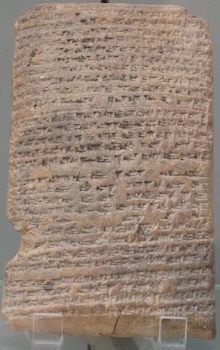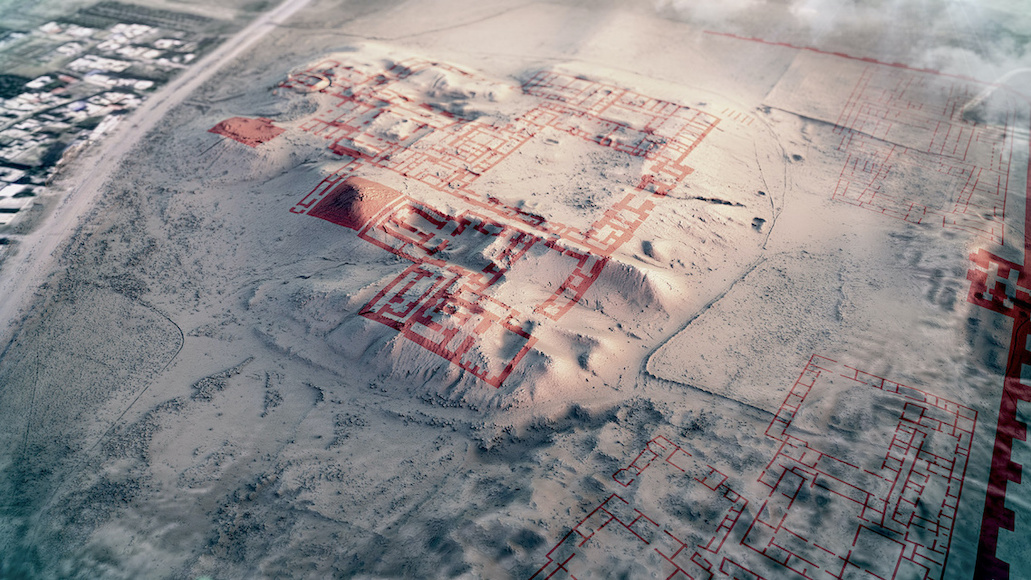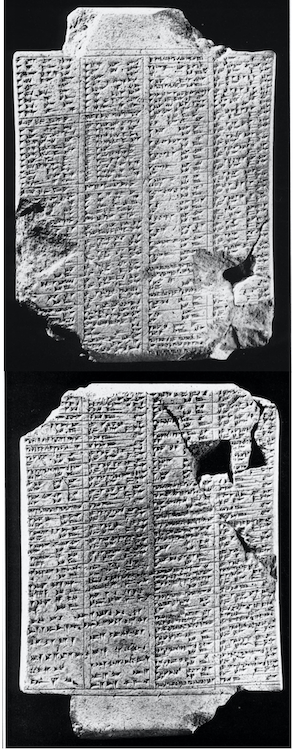You are seeing an unstyled version of this site. If this is because you are using an older web browser, we recommend that you upgrade to a modern, standards-compliant browser such as FireFox [http://www.getfirefox.com/], which is available free of charge for Windows, Mac and Linux.
Neo-Assyrian Archival Texts from Dur-Šarrukin

In 717 BC, Dur-Šarrukin (modern Khorsabad) was founded by Sargon II [/saao/aebp/essentials/kings/sargonii/index.html] (r. 721–705 BC) as his new royal residence on the land of the town of Maganuba (SAA 12 19 [/atae/P336273]). At the same time, a province of the same name was established, which encompassed the Halahhu region. The close connection between Dur-Šarrukin and Halahhu emerges on the one hand from a letter dated to the reign of Sargon, according to which a village in the Halahhu region was assigned to Dur-Šarrukin (SAA 1 106 [/atae/P334328]). On the other hand, this relationship is clear from the comparison of the purchase document, with which Nabû-kabti-ahhešu, "palace scribe of Sargon, king of Assyria," bought land of the village of Buruqu in 709 BC in connection with the construction of Dur-Šarrukin (SAA 6 31 [/atae/P337149]), and a deed from the reign of Adad-nerari III (810–783 BC), in which this same village was called "Buruqu of the land of Halahhu" (CTN 2 64 [/atae/P224515]). Whereas Halahhu was never identified as a province in the Assyrian sources of the first millennium, it certainly held that status in the second half of the second millennium BC. The fact that Maganuba is described as a "town that [lies] like a fortress in the district of Nineveh" (SAA 12 19 [/atae/P336273]) demonstrates that prior to the establishment of the province of Dur-Šarrukin, the Halahhu region formed the eastern part of the province of Nineveh. From the Bible (2 Kings 17:6), Halahhu – and therefore Dur-Šarrukin – is known as one of the destinations of the deported Israelites after the Assyrian conquest of Samaria under Shalmaneser V [/saao/aebp/essentials/kings/shalmaneserv/index.html] (r. 726–722 BC), an operation that was only completed during the reign of his brother and successor Sargon II.

The reverse of the sale document SAA 6 31 [/atae/P337149], as displayed in the Louvre (Paris). Photo by Karen Radner (2009).
Subsequent to the establishment of the new province, governors of Dur-Šarrukin served as year eponyms of the Assyrian Empire in 693 BC, in 664 BC, and in the period after 648 BC (Kanunayu). The province is mentioned in letters from the reigns of Sargon II (SAA 1 36; SAA 1 124; SAA 1 192 [/atae/P334520,P334135,P313435]) and Esarhaddon (SAA 13 92; SAA 13 99; SAA 13 114 [/atae/P334247,P334368,P334678]), as well as in legal documents from Nineveh (SAA 6 340; SAA 14 69 [/atae/P335316,P240279]) and from Ma'allanate (ACP 26 [/atae/P522875] written during the time of Ashurbanipal. These attestations from the 7th century BC highlight that the province of Dur-Šarrukin continued to exist beyond the death of Sargon II, even though the city itself lost its briefly-held role as the capital of the Assyrian Empire to Nineveh, located at a distance of only twenty kilometers southwest of Dur-Šarrukin.
The site of Khorsabad has been repeatedly excavated, although much of it remains to be explored, especially in the enormous lower town that is largely untouched by archaeological investigation. The first excavations were undertaken between 1843–1855 by Paul-Emile Botta and Victor Place on behalf of the Louvre. Between 1928–1935, excavations at Khorsabad were resumed by a team from the Oriental Institute of the University of Chicago. Materials from these excavations, and especially the monumental carved stone slabs decorating the palace of Sargon II, are exhibited in the Louvre, the Oriental Institute and the Iraq Museum. In 1957, an Iraqi team led by Fuad Safar excavated the temple of the Sebitti gods, and some of the objects recovered used to be on display in the Mosul Museum where they greatly suffered at the hands of the so-called "Islamic State of Iraq and Syria" (ISIS) from 2014 onwards, as did the site of Khorsabad, which was targeted for illicit excavations and subsequently served as a battle field in clashes with Kurdish troops in 2016 that contributed to the ousting of ISIS from the Mosul region.

An aerial view of the archaeological site of Khorsabad, overlaid with the plan of the palace of Sargon II. From https://archeologie.culture.fr/proche-orient/en/a-propos/khorsabad [https://archeologie.culture.fr/proche-orient/en/a-propos/khorsabad]
While the excavations at Khorsabad yielded a larger number of royal inscriptions in the name of Sargon II, only relatively few cuneiform tablets have been excavated, especially when compared to the other Assyrian capital cities Assur, Kalhu and Nineveh. The early French excavations brought to light only two letters from the royal correspondence of Sargon II (SAA 5 81; SAA 5 100 [/atae/P337151,P337150] – the rest was apparently moved to Nineveh during the reign of his successor Sennacherib, as the material was found there), the aforementioned sale deed associated with the purchase of land for the foundation of the new capital (SAA 6 31 [/atae/P337149]), and four sealed tags that once identified deliveries as coming from the provincial capitals Arrapha (modern Kerkuk; SAA 11 61; SAA 11 62 [/atae/P336696,P336697]) and Naṣibina (modern Nusaybin; SAA 11 63; SAA 11 64 [/atae/P336698,P336699]). While working at the temple of the god Nabû, the Chicago excavations unearthed more texts, but most of these remain still unpublished; notable exceptions are a manuscript of the Assyrian King List [/riao/kinglists/assyriankinglist/khorsabadlist/index.html] in the shape of an amulet and a fragmentary copy of a royal ritual (SAA 20 45 [/atae/P336160]). The unpublished materials include lexical lists, prayers, and omen texts, in addition to some fragmentary legal and administrative documents that date to the final decades of the Assyrian Empire.

A version of the Assyrian King List [/riao/kinglists/assyriankinglist/khorsabadlist/index.html] inscribed on a clay tablet in amulet shape, found by the Chicago team during the excavation season of 1932/33 in the Nabû temple at Dur-Šarrukin. The text lists the Assyrian kings up to and including Aššur-nerari V (754-745 BC). Photos of the obverse (top) and reverse (bottom), reproduced from I.J. Gelb, "Two Assyrian King Lists," Journal of Near Eastern Studies 13 (1954), pl. XVI–XV.
For some details on some of the Neo-Assyrian texts mentioned above, see:
- I.J. Gelb, "Two Assyrian King Lists," [http://www.jstor.org/stable/542243] Journal of Near Eastern Studies 13 (1954) 209–230.
- Olof Pedersén, Archives and Libraries in the Ancient Near East 1500–300 B.C., [http://uu.diva-portal.org/smash/get/diva2:88568/FULLTEXT01.pdf] Bethesda 1987, 155–158 (discussion of the texts from Nabû temple).
- Arno Poebel, "The Assyrian King List from Khorsabad," [http://www.jstor.org/stable/543052] Journal of Near Eastern Studies 1 (1942), 247–306.
- Karen Radner, "Erntearbeiter und Wein: neuassyrische Urkunden und Briefe im Louvre," [https://epub.ub.uni-muenchen.de/25080/] State Archives of Assyria Bulletin 11 (1997) 3–29 (pp. 19–23, 27–28: SAA 6 31; pp. 23–24, 29: SAA 5 81; SAA 5 100 – copies, new editions and commentaries).
For Dur-Šarrukin as the royal residence of Sargon II, and its construction, see https://www.ucl.ac.uk/sargon/essentials/cities/durarruken/ [https://archeologie.culture.fr/proche-orient/en/a-propos/khorsabad].
For photographs and videos concerning the archaeological site of Khorsabad and the Khorsabad collections in the Louvre, see https://archeologie.culture.fr/proche-orient/en/a-propos/khorsabad [https://archeologie.culture.fr/proche-orient/en/a-propos/khorsabad]. We especially recommend the 5-minute video offering a digital reconstruction of Dur-Šarrukin and the citadel mound with the royal palace and the temples that enables a virtual visit to the city.
This sub-project of the Archival Texts of the Assyrian Empire (ATAE) [/atae/] Project includes annotated (lemmatized), open-access versions of eight Neo-Assyrian texts from Dur-Šarrukin published in the following four volumes of the University-of-Helsinki-based State Archives of Assyria [/saao/] series:
- SAA 05 [/saao/saa05/] = G. B. Lanfranchi and S. Parpola, The Correspondence of Sargon II, Part II: Letters from the Northern and Northeastern Provinces (State Archives of Assyria 5), Helsinki 1990
- SAA 06 [/saao/saa06/] = T. Kwasman and S. Parpola, Legal Transactions of the Royal Court of Nineveh, Part I: Tiglath-Pileser III through Esarhaddon (State Archives of Assyria 6), Helsinki, 1991
- SAA 11 [/saao/saa11/] = F. M. Fales and J. N. Postgate, Imperial Administrative Records, Part II: Provincial and Military Administration (State Archives of Assyria 11), Helsinki, 1995
- SAA 20 [/saao/saa20/] = S. Parpola, Royal Rituals and Cultic Texts (State Archives of Assyria 20), Winona Lake, IN, 2017
Click here [/atae/durszarrukin/pager] to visit the ATAE/Dur-Šarrukin corpus, this link [/atae/] to visit the Main ATAE Portal, or this link [/atae/pager] to browse the entire ATAE corpus.
ATAE is a key component of the Archival Texts of the Middle East in Antiquity (ATMEA) sub-project of the LMU-Munich-based Munich Open-access Cuneiform Corpus Initiative [https://www.en.ag.geschichte.uni-muenchen.de/research/mocci/index.html] (MOCCI; directed by Karen Radner and Jamie Novotny). Funding for the ATAE corpus project has been provided by LMU Munich and the Alexander von Humboldt Foundation (through the establishment of the Alexander von Humboldt Chair for Ancient History of the Near and Middle East).
For further details, see the "About the project" [/atae/abouttheproject/index.html] page.

Home Page banner credit
Modern reconstruction of the citadel at Dur-Šurrukin; view from the north. From https://archeologie.culture.fr/proche-orient/en/a-propos/khorsabad [https://archeologie.culture.fr/proche-orient/en/a-propos/khorsabad].